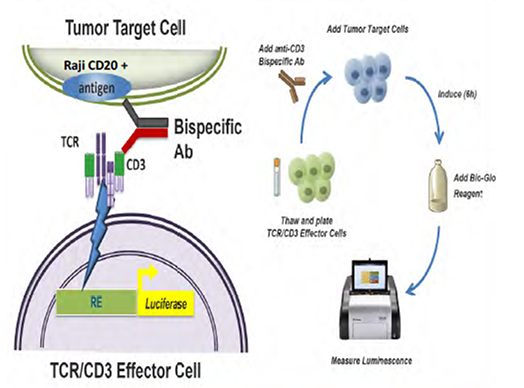| Drug Name | CD3xCD20 bsAb |
| Description | Anti-CD3/CD20 bispecific antibody (CD3xCD20 bsAb) is able to bring T cells to tumor microenvironment. Experiments demonstrated that low-toxic CD3xCD20 bsAb has a strong T cell activation capability to kill cancer cells: in vitro experiments showed that CD3xCD20 bsAb can effectively kill Rituximab-resistant tumor cells; in vivo experiments confirmed that CD3xCD20 bsAb significantly induced tumor regression and remission in humanized mouse tumor model. |
| Target | CD3; CD20 |
| Drug Modality | Bispecific Antibody |
| Indication | Lymphoma |
| Product Category | Immunotherapy |
| Mechanism of Action | CD3xCD20 bsAb selectively binds CD20 antigen on the surface of B cells and CD3 antigen on the surface of T cells |
| Status | Preclinical |
| Patent | Patent applications filed |
Protheragen Inc. is actively seeking partnership to further develop CD3xCD20 bsAb. Potential collaboration can be strategic alliance, licensing, or marketing agreement.
We look forward to hearing from you.
| Introduction | The CD3 antigen is a protein complex composed of four distinct chains: CD3γ chain, CD3δ chain, and two CD3ε chains. These chains are highly homologous cell surface proteins that are members of the immunoglobulin superfamily and contain a single extracellular immunoglobulin domain. The transmembrane region of these CD3 chains is negatively charged, allowing them to associate with the positively charged T cell antigen receptor (TCR) chains (TCRα and TCRβ). The intracellular tails of the CD3 chains contain a single conserved motif, known as an immunoreceptor tyrosine-based activation motif (ITAM) which is essential for the signaling capacity of the TCR. Association of the CD3 chains with TCR and the ζ-chain (accessory molecules of TCR) generates an activation signal in T lymphocytes. Thus, the TCR complex is composed of the TCR, zeta-chain and CD3 molecules. |
| Pathway | CD3 is involved in the signal transduction of activated T lymphocytes. |
| Major Conditions | Cancer; Immunological disorders; Neurological disorders; etc. |
| Introduction | This gene encodes a member of the membrane-spanning 4A gene family. Characterized by common structural features and similar intron/exon splice boundaries, members of this nascent protein family display unique expression patterns among hematopoietic cells and nonlymphoid tissues. CD20 is localized to 11q12, encoding a B-lymphocyte surface molecule, which plays a role in the development and differentiation of B-cells into plasma cells. Alternative splicing of this gene results in two transcript variants which encode the same protein. |
| Approved Name | Membrane spanning 4-domains A1 |
| Official Symbol | MS4A1 |
| Gene Type | Protein coding |
| Synonyms | B1; S7; Bp35; CVID5; MS4A2; LEU-16 |
| Ensembl | ENSG00000156738 |
| Gene ID | 931 |
| mRNA Refseq | NM_152866.3; NM_021950.3 |
| Protein Refseq | NP_068769.2; NP_690605.1 |
| OMIM | 112210 |
| UniProt ID | P11836 |
| Chromosome Location |
11q12.2 |
| Gene Structure | CD20 gene is 16 kb long and contains 8 exons. |
| Pathway | CD20 participates in antibody-dependent cellular cytotoxicity (ADCC), complement-dependent cellular cytotoxicity (CDCC) and cell growth. |
| Major Conditions | Cancers; Cardiovascular disorders; Hematologic diseases; Neurological disorders; etc. |
Bispecific antibodies targeting both CD20 and CD3 activate T cells to treat lymphoma with high CD20 expression. Of all the tumors, lymphoma is a highly heterogeneous malignant tumor. 90% of lymphomas are NHL and the remaining 10% are HL. For both HL and NHL, the primary diagnosis involves biopsy of diseased lymphoid tissue and the identification of subtypes by immunophenotype analysis.
Although one of the major types of lymphoma, HL is generally less common than NHL. By 2030, estimated 583,681 cases of NHL will be diagnosed worldwide, and the total healthcare costs are expected to reach about $16 billion; 91,000 cases of HL will be diagnosed, and the total associated costs will be close to $1.8 billion.
In 2015, about 23,900 people died from HL worldwide, and 231,400 from NHL, compared to an age-standardized mortality rate of 3.5 per 100,000. The treatment of lymphoma should be determined according to the cancer subtype, stage, individual physical condition and other factors. Currently, the main treatments for lymphoma include multi-drug combination chemotherapy, radiotherapy, and stem cell transplantation.
Since CD20 is expressed in more than 95% of B-cell lymphoma and not in other normal tissues, anti- CD20 antibody drugs have been the first line treatment for almost all B-cell lymphoma / leukemia. There are three main mechanisms by which anti-CD20 monoclonal antibody kills B cell-derived tumors, namely, antibody-dependent cytotoxicity (ADCC), complement-dependent cytotoxicity (CDC), and direct effect caused by antibody binding to CD20 molecule.
The CD3/TCR complex regulates the infiltration of the cytotoxic T lymphocytes into the malignant cells to subsequently induce cell death. Bispecific antibodies can activate T cells by targeting CD3 and guide effector T cells to kill lymphoma cells by recognizing CD20.
After in-depth genetic engineering, CD3xCD20 bsAb shows greater advantages over other similar bispecific antibody: high specificity, moderate affinity, no T cell extinction, and no obvious cytokine release. Because of its unique binding site, CD3xCD20 bsAb has a strong killing effect on CD20 target cells, especially on rituximab resistant lymphoma cells.

All relevant patent applications have been filed.
